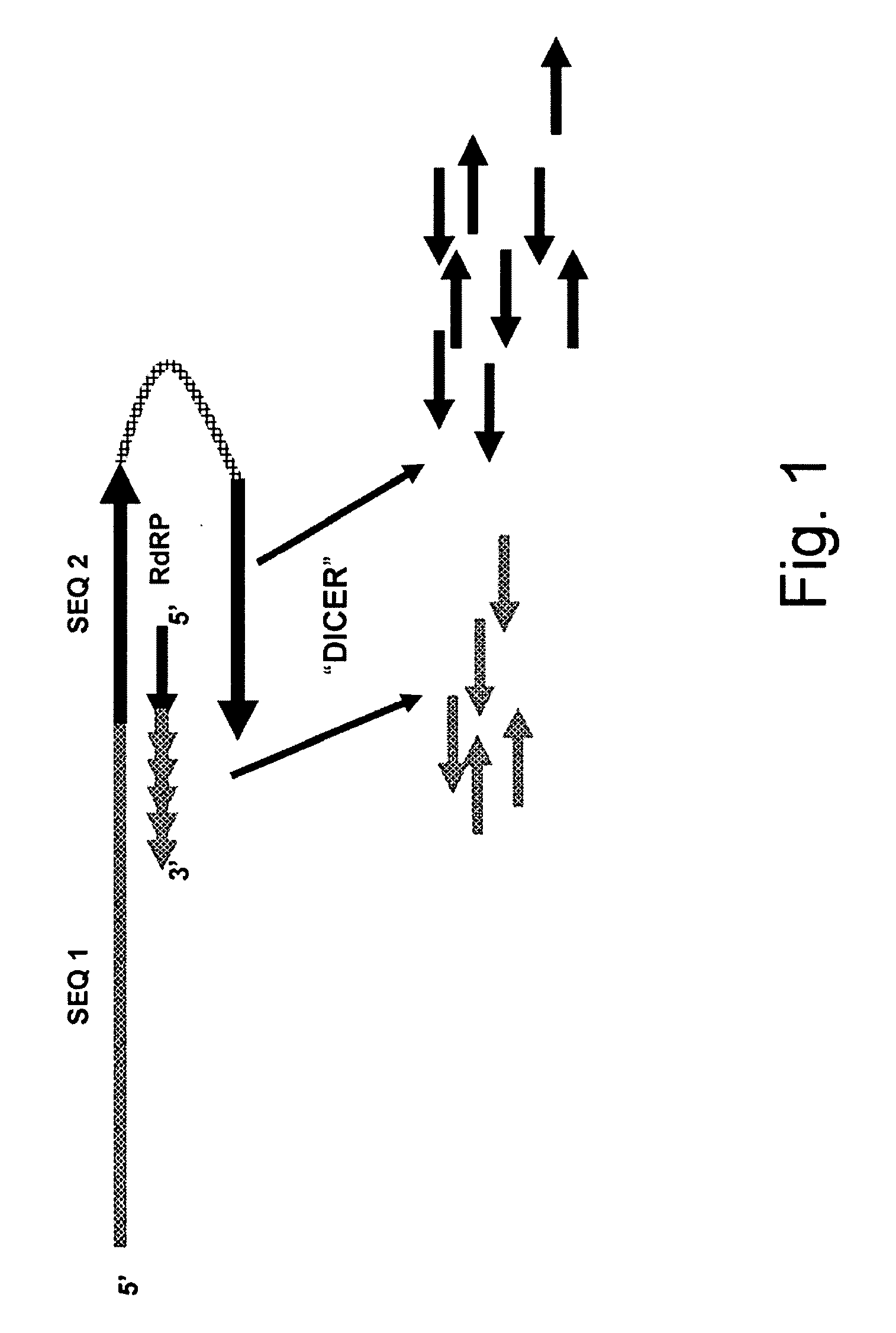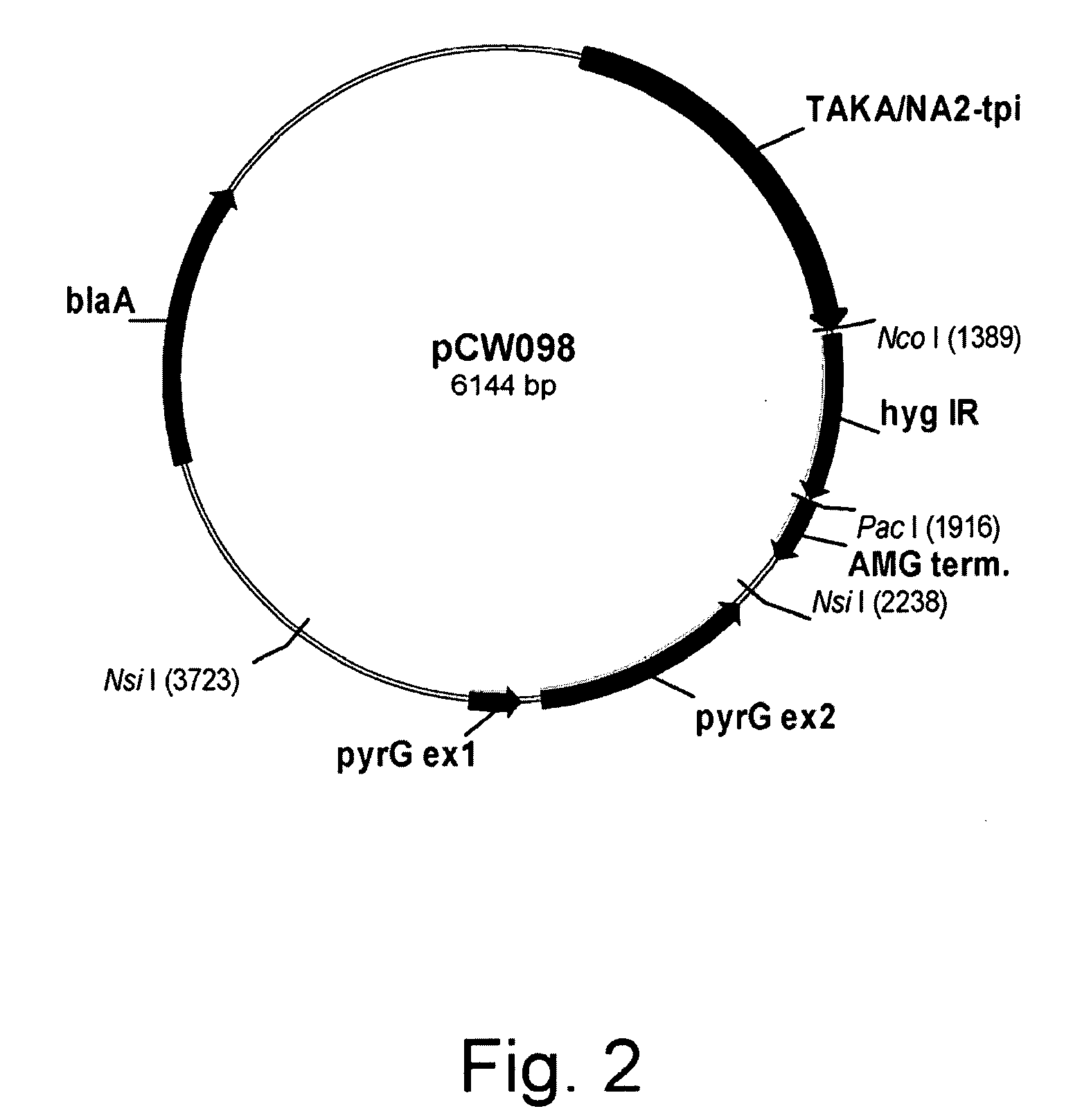Methods of Eliminating or Reducing Expression of Genes in Filamentous Fungal Strains by Transitive RNA Interference
- Summary
- Abstract
- Description
- Claims
- Application Information
AI Technical Summary
Benefits of technology
Problems solved by technology
Method used
Image
Examples
example 1
Construction of Plasmid pCW098
[0152]Plasmid pCW098 was constructed to contain the TAKA / NA2-tpi leader hybrid promoter (U.S. Pat. No. 6,461,837), an inverted repeat (hyg IR) made from a portion of the Escherichia coli hygromycin resistance gene (Kaster et al, 1983, Nucleic Acids Res. 11: 6895-6911), the Aspergillus niger amyloglucosidase (AMG) terminator (Hata et al., 1991, Agric. Biol. Chem. 55: 941-949, and the Aspergillus nidulans pyrG gene as a selectable marker (Ballance and Turner, 1985, Gene 36: 321-331).
[0153]To express a double-stranded RNA (dsRNA) derived from the Escherichia coli aph(4) (hygB) gene (Kaster et al., 1983, supra), one half of the inverted repeat, 199 base pairs from within the open reading frame of the aph(4) gene, was PCR amplified using a sense strand primer possessing a Not I restriction site and an antisense primer possessing a 5′ Sma I or Xma I restriction site, as shown below.
Primer cwhygnot.1 (sense):(SEQ ID NO: 1)5′-gcggccgcGCGATGTTCGGGGATTCCCAATACGAG...
example 2
Construction of Plasmid pCW099
[0160]Plasmid pCW099 was constructed to contain the TAKA / NA2-tpi leader hybrid promoter, a fragment of the Aspergillus oryzae wA gene (SEQ ID NO: 5 for the full-length genomic DNA sequence and SEQ ID NO: 6 for the deduced amino acid sequence), the Escherichia coli hygB inverted repeat (hyg IR), the Aspergillus niger amyloglucosidase (AMG) terminator, and the Aspergillus nidulans pyrG gene as a selectable marker.
[0161]A 176 bp fragment of the Aspergillus oryzae wA gene (SEQ ID NO: 7 for the DNA sequence and SEQ ID NO: 8 for the deduced amino acid sequence thereof) was PCR amplified from plasmid plus wA flanking sequence rescued from Aspergillus oryzae strain P2-5.1 (WO 05 / 056772, Examples 27 and 28) using primers cwwanco.1corr (sense) and cwwanot.1a (antisense) shown below. The sense primer was engineered to have a Nco I site at the 5′-end and the antisense primer was engineered to have a Not I site at the 5′-end.
Primer cwwanco.1corr (sense):(SEQ ID NO: ...
example 3
Construction of Plasmid pEFer14
[0165]Plasmid pEFer14 was constructed to contain the TAKA / NA2-tpi leader hybrid promoter, a 176 bp fragment of the Aspergillus oryzae wA gene, the Escherichia coli hygB inverted repeat (hyg IR), the Aspergillus niger amyloglucosidase (AMG) terminator, and the full-length Aspergillus nidulans amdS gene as a selectable marker.
[0166]Plasmid pCW099 digested with Nco I and Pac I was purified by 1% agarose gel electrophoresis in TAE buffer. A 698 bp fragment containing the 176 bp wA fragment, and hygB inverted repeat was extracted using an ULTRAFREE®-DA column (Millipore, Billerica, Mass., USA) according to the manufacturer's instructions. The purified fragment was ligated to Nco I / Pac I digested pAlLo1 (WO 05 / 056772, Example 1) to create pEFer14 (FIG. 4).
PUM
| Property | Measurement | Unit |
|---|---|---|
| Fraction | aaaaa | aaaaa |
| Fraction | aaaaa | aaaaa |
| Fraction | aaaaa | aaaaa |
Abstract
Description
Claims
Application Information
 Login to View More
Login to View More - R&D
- Intellectual Property
- Life Sciences
- Materials
- Tech Scout
- Unparalleled Data Quality
- Higher Quality Content
- 60% Fewer Hallucinations
Browse by: Latest US Patents, China's latest patents, Technical Efficacy Thesaurus, Application Domain, Technology Topic, Popular Technical Reports.
© 2025 PatSnap. All rights reserved.Legal|Privacy policy|Modern Slavery Act Transparency Statement|Sitemap|About US| Contact US: help@patsnap.com



